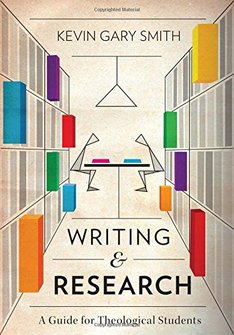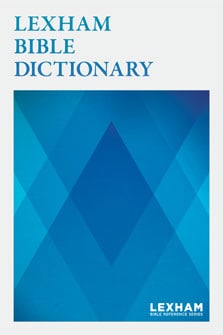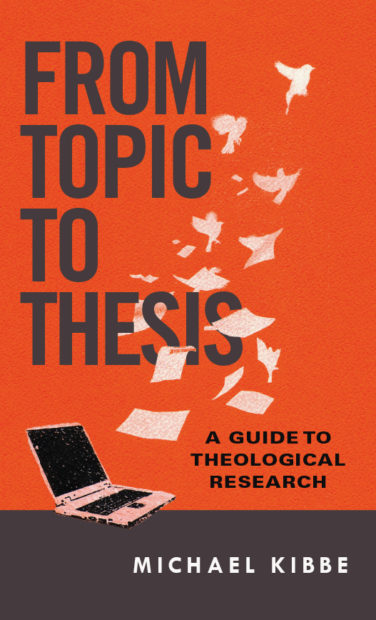Introduction
Research papers are one of the best ways to learn in seminary—which is why so many teachers assign them. A research paper trains you in how to gather information, interpret it, and present an informed opinion persuasively.
And yet seminary research papers can be very frustrating if you don’t follow a basic, tried-and-true process:
- Study
- Write
- Cite
- Submit
Study
There are four steps to the study process: narrowing your focus, gathering research, deciding your thesis, and building an outline.
1. Narrow your focus
All the best guides (see list below) share a common thread of advice: narrow your focus. Here are three tips for narrowing the scope and focus of your paper so you don’t bite off more than you can (or should) chew.
- Mind your word or page count. If your paper is supposed to be fewer than 10 pages, you’ll need a narrower topic you can address substantively within that amount of space.
- Research what interests you. You’ll be spending a lot of time researching, so if possible, choose a topic you truly want to learn about. Tip: If you’re in seminary, write as many of your papers on one topic as possible so that you become a bit of an expert on it.
- Narrow your topic. The narrower your topic, the easier your process. That’s because you can be more selective in what to research and argue. For example, “What led to the Reformation?” is a giant topic—book-length, really. But something like, “What was Martin Luther’s 3rd of the 95 Theses, and how did he come to it?” is a subtopic you could write a short, interesting paper on.
Note: Only choose topics of which you have some general knowledge. You may need to read introductory material at length to write narrowly on an unfamiliar topic.
Resources for paper writing
- How to use Logos for writing and research (video), a great place to start.
- How to write an effective paper from the University of Toronto.
- Advice on theological writing from the esteemed John Frame. Frame’s words have more to do with the writer (you) than the mechanics.
- A well-written 14-page guide to writing research papers in history and theology

Writing & Research: A Guide for Theological Students by Kevin Gary Smith
Written in a simple yet engaging style, Dr. Kevin Smith applies his years of experience and expertise in scholarly writing and research in this introduction for new and continuing undergraduate or postgraduate students. This publication provides helpful guidelines and illustrations on all the elements that go into producing an academic work.
2. Gather research
Next to narrowing your focus, nothing is more important for the research process than knowing where and how to gather sources. It also will lead to much higher quality work.
Note: Though the next step in our process has to do with deciding your thesis, you may have a provisional thesis statement even by this point. If you do, this part will move quicker, because you’ll know just what to look for. If not, that’s okay—you can read more broadly to find a topic that interests you.
Broadly speaking, there are four main places to conduct your initial research. The following is adapted from Surviving and Thriving in Seminary (Lexham Press, 2016).
Dictionary articles
Biblical and theological dictionaries summarize and introduce a particular topic in as concise a manner as possible. For this reason, they are the best place to start the research process for every paper. Reading a dictionary article will provide you with a quick and comprehensive overview of your subject. After reading several dictionary articles, you will begin to feel you have a general understanding of the topic, and this will provide you with a solid base from which to begin reading further.
Dictionary articles also provide a basic bibliography on the subject at the end of each article. Flipping to the end of the article will usually provide you with a good bibliography immediately. If you make note of the sources in the bibliographies from different dictionaries on the same topic, you will likely already have more sources than you can handle. If you end up with more sources than you can realistically track down, prioritize sources in more recent dictionaries. A dictionary article written in 1950 may be very valuable, but its bibliography will not have more recent scholarship on the issue. Dictionary articles apply best to biblical studies, theology, and church history. Ask your professors which dictionaries they recommend you use, or see the sidebar for our recommendations.
Commentaries
Commentaries apply primarily to exegesis papers and papers related to biblical theology. Commentaries, like dictionary articles, attempt to give a summary of a particular issue—only this time the issue is the proper meaning of a particular section of the Bible. Some commentaries are more comprehensive than others; it largely depends on the commentary series. To determine which commentaries are the best for the passage you are looking at, we recommend asking your professor or consulting the website bestcommentaries.com. Take care when choosing a commentary, because not all are created equal. For research papers, academic commentaries are what you need to use, as they engage with the academic discussion of the biblical book. Bestcommentaries.com is helpful in this regard, since it tags commentaries as technical, pastoral, or devotional.
Like dictionary articles, each commentary will include a bibliography. Some commentaries have a selected bibliography at the end of a passage; others have all their sources listed in the general bibliography for the whole book. Even without a selected bibliography, you can gather sources by taking a good look at the footnotes to see what is cited. Consult a few top-notch academic commentaries, and you will have a wealth of sources to use. Something to also keep in mind is the age of the commentary. The newer the commentary, the more up-to-date the bibliography.
Book bibliographies
If you are researching a particular topic and have access to either a book or a book chapter that covers the topic, then the bibliography and footnotes of these sources will provide you with a wealth of possible sources for your own research. Like the above methods, you will need to judge for yourself based on the title if the source is worth your time.
ATLA serials
The above suggestions will usually yield enough sources that you will not need to go hunting for more (unless you are working on a thesis or a topic not well covered by a dictionary). If your bibliography for your paper is still thin, ATLAS is the place to go. ATLA (American Theological Library Association) Serials is an online collection of journals for the study of religion. This includes not only Bible and theology, but the area of practical theology and even other religions as well. This database is a subscription service, and every good seminary library has access to it. ATLAS makes every part of its sources searchable, so you can search by keyword to find journal sources.

Lexham Bible Dictionary (free)
As dictionaries go, this one is quite recent—and it’s free, which is shocking given its quality. You’ll turn to this one often. Bonus: It’s digital, which makes it even easier to navigate and cite.
Other recommended dictionaries
The following come recommended by H. Daniel Zacharias and Benjamin K. Forrest, authors of Surviving and Thriving in Seminary (Lexham Press, 2016).
- Alexander, T. Desmond, and Brian S. Rosner, eds. New Dictionary of Biblical Theology.Downers Grove, IL: IVP Academic, 2000.
- Cross, F. L., and Elizabeth A. Livingstone, eds. The Oxford Dictionary of the Christian Church. Oxford; New York: Oxford University Press, 2005.
- Di Berardino, Angelo. Encyclopedia of Ancient Christianity. Downers Grove, IL: IVP Academic, 2014.
- Freedman, David Noel, Gary A. Herion, David F. Graf, John David Pleins, and Astrid B. Beck, eds. The Anchor Yale Bible Dictionary. New York: Doubleday, 1992.
- Green, Joel B., Jeannine K. Brown, and Nicholas Perrin, eds. Dictionary of Jesus and the Gospels. Carlisle, Cumbria, U.K.: Paternoster Press, 2000.
- McKim, Donald K., ed. Dictionary of Major Biblical Interpreters. Downers Grove, IL; Nottingham, England: InterVarsity Press, 2007.
* The authors recommend all works in IVP’s Bible Dictionary Series.
Logos Bible Software (free)
Logos is a collection of digital books and periodicals designed for theological research. Using its various guides (such as the Topic Guide, Passage Guide, or Sermon Starter Guide), you can conduct relevant searches across your whole library.
3. Decide a thesis
After choosing a topic and familiarizing yourself with it, you are ready to decide and draft your thesis. Your thesis is your paper’s north star. It directs the resources you use, the points you make, even the sentences you strike—everything in your paper exists to support your thesis.
Your thesis is your main point or argument and should:
- Be about one sentence long
- Appear near the end of your paper’s introduction
- Be arguable, not a simple fact
On that last point: a proper thesis is one you have to prove. You need to make a statement someone could argue against.
- Not a thesis: Martin Luther drafted the 95 Theses.
- Thesis: Luther’s 95 Theses were born from his personal religious experience.
You will be collecting data and insights to support your thesis. Think of your paper as one side of a debate. You are making a case for the truth of your thesis, citing supporting evidence as well as answering likely objections.
Ideally, your thesis is also original—a point no one has argued before. This is harder to achieve until further on in your academic career.

From Topic to Thesis: A Guide to Theological Research by Michael Kibbe
Adapted from the publisher description: This affordable and accessible tool walks students through the research process, focusing on five steps: finding direction, gathering sources, understanding issues, entering discussion, and establishing a position. Its goal is to take students directly from a research assignment to a research argument—in other words, from topic to thesis.
4. Build an outline
The outline is the skeleton of your work and will do wonders for you in terms of organization.
Do not just start writing. If you write without a map for where you will go, you will wander. More than likely, you’ll spend too much time on cursory points and then scrunch the most important parts of your paper down to stay within your word count limit.
Instead, outline the flow of your paper.
Example outline
Generally speaking, you can think of your outline in terms of paragraph units.
- Introduction (one paragraph or several, depending on paper length)
- Body of Work
- Main Point (several pages)
- Subpoint (several paragraphs)
- Supporting point (paragraph)
- Supporting point (paragraph)
- Supporting point (paragraph)
- Subpoint (etc.)
- Subpoint (etc.)
- Subpoint (several paragraphs)
- Main Point (several pages)
- Main Point (several pages)
- Main Point (several pages)
- Conclusion (one paragraph or several, depending on paper length)
The content in “supporting point” paragraphs will be insights from your research. So here you are plugging in material you’ve read, either as paraphrased material or direct quotes (both cited, see below), to support your conclusions.
Why write an outline?
The value of a detailed outline is you can scope out the exact flow of your paper, at least provisionally. It’s true that while writing your paper, your outline will shift—this is normal and right. You may end up placing more paragraphs under a subpoint than you first envisioned, perhaps even realizing that a subpoint is substantive enough to be a main point.
But your process will be much smoother, and your paper will flow much better, if you have an outline sorted out before you begin writing.
Logos Sermon Builder
If you are conducting your research in Logos (or even if you aren’t, really), the Sermon Builder Tool is extremely helpful for building your outline. Though it’s designed for sermons, its features are ideal for organizing your thoughts and gathering your research into an outline.
Explore the Sermon Builder tool.
Logos Notes Tool
In addition to the above, Logos notes and highlights are helpful for research. Any note or highlight you make on a resource is automatically saved and collected, so you can easily access them later. This gives you a simple paper trail for your research process.
Write Your Paper
Assuming you’ve filled out a substantive outline, this is the fun part of the process. You’re finally stitching your research together into a finished product.
There is much to say about what makes for good theological writing (and you should read all of it), but a few pieces of advice are worth highlighting:
- Follow the style guide of your college or university. If none exists or this doesn’t apply, know that Turabian is the standard style among biblical and theological writing.
- Write to inform, not impress. Many amateur writers adopt a high-falutin voice when they begin writing. Don’t. Write as if your professor (or your mother, depending on your audience) asked you a simple question and just wants a plain answer. Avoid verbal fluff like “the aforementioned” and cliches like “since the dawn of time.” Generally speaking, write how you talk.
- Pay attention to topic sentences and transitions. There are a hundred ways for a paper to go wrong, but clear topic and transition sentences will save you from many of them. Think of these as signposts guiding your reader:
- Topic sentences are the first sentence of a paragraph and tell the reader what the paragraph will be about. Think of it like the writing in marker on a moving box: “KITCHEN, plates and cutting boards.” For example, “Martin Luther experienced intense inner turmoil concerning his sin” would be a good topic sentence for a paragraph about Luther’s many failed attempts to deal with his sin.
- Transition sentences are the last sentence in a paragraph that connect what was just said to what’s about to be said. For example, you might conclude the above paragraph with, “It was this unceasing turmoil that led Luther, in desperation, to reconsider justification,” and then begin the next sentence with this topic sentence, “A rediscovery of biblical justification was at the heart of Luther’s 95 Theses.”
Tip: Many writers find it helpful to imagine a real person as the audience of their paper. This helps them use more grounded, simple language and break through the clutter to get straight to the point. For example, you might imagine that you are writing to your teenage sibling or a college student with zero knowledge of the Bible.
“How to write an effective paper” by Tyndale Seminary
This is a mercifully short yet comprehensive guide, and it’s organized well. Consider it a crash course in the most important rules of theological writing.
This is a short, punchy, classic work about writing. It mainly covers grammar and style—from the right way to use commas to how not to be boring. If you ever write anything, you should read this book.
Cite Sources
If you are currently in Bible college or seminary, you can ignore this and refer to your Academic Handbook, which will cover this material in greater detail.
If you are not, consider these three broad rules for citing your sources.
1. Cite everything
First things first: never plagiarize. As the adage goes, “If you’re unsure, cite it.” That is, if you have any inkling that what you are saying is not your own idea, cite whose idea it is (and if you don’t know, look; and if you still can’t find out, say something like, “This is not my original idea, and despite looking at length, I cannot seem to find where I heard this.”).
The single most important part of the citation discussion is that you acknowledge the source of any idea that is not your own or already well known and circulated (e.g., in theological writing you do not have to cite John 3:16 when you mention that believing in Jesus gives you eternal life).
2. Track your citations from the start
You should be thinking about your bibliography from the moment you begin researching. If you consult a resource—even one you don’t think you’ll cite in your paper—take down that source’s information. You’ll be glad you did.
And with that, create a system. A great tool is Zotero. You can use it to track all your research and easily generate citations in various styles (APA, Turabian, etc.). John Frame also has some helpful points on using sources in the earlier parts of this article.
3. Cite correctly
It is not enough to drop an article URL or a book title with a page number. A charge of plagiarism can be leveled at you even for incorrectly citing material.
Again, if you are in school, follow the rules of your academic handbook. If not, adopt a common style guide like APA or Turabian, and consult online guides like EasyBib or the Chicago Manual of Style for help.
More than likely, your paper will include in-text citations (usually footnotes) and a bibliography. The format of each one is different, as you’ll see from the guides mentioned.
Logos Bible Software
Logos will automatically cite your sources any time you copy-paste from Logos into a Word document, making it easy to build your bibliography in your preferred style.
Read about how Logos automates citation.
Submit
Now that you have your paper written, your sources cited, and your bibliography written, it’s time for the finishing touches.
These have to do with grammar and aesthetics, primarily. Here’s a recommended checklist:
- Make sure your paper is all one font type and size. Generally fonts like Times New Roman or Arial in size 12 are safe.
- Double-check that page numbers are accurate.
- Create a title page, typically containing the title of your paper, the course it’s for, your school, your name, and the date.
- Print out your paper and don’t read it for 24 hours. Approaching your paper with fresh eyes will help you see many errors and opportunities for improvement. (In fact, do this step twice if possible—once after your initial draft is complete, and again before you print the paper you’ll hand in.)
- After 24 hours, read the printed version of your paper, marking corrections with a red pen. If your copy is particularly marked at the end of this process (more than five corrections per page, on average), repeat this step.
- Create a backup of your paper, whether digital or physical (or both).
- Hand in your paper in a folder. (This may seem overboard, but packaging your paper like it’s important will give your professor the impression that you took the assignment seriously.)
Conclusion
The road to a solid research paper isn’t short, but it is worn. Follow these steps and you’ll arrive at a solid paper—but even better, you’ll have learned a lot in the process, trained your mind in the art and craft of critical thinking, and become a better writer in the process.





